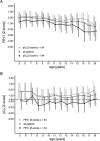Arterialized oxygen tension and unfavorable clinical outcomes in pediatric cystic fibrosis
- PMID: 41132759
- PMCID: PMC12540158
- DOI: 10.3389/fped.2025.1653323
Arterialized oxygen tension and unfavorable clinical outcomes in pediatric cystic fibrosis
Abstract
Introduction: Maintaining good lung function is a primary goal in managing Cystic Fibrosis (CF). As spirometry lacks sensitivity for detecting mild lung disease, early progression often remains unrecognized. To overcome this limitation, more sensitive monitoring tools are needed. We evaluated arterialized oxygen tension (pO2) as an easily accessible, and widely applicable surveillance method.
Methods: In this retrospective observational single-center cohort study, arterialized gas exchange was assessed in 103 young people with CF (47 females, 56 males, aged 5-18 years). Trends from baseline (age 5 years) to early adulthood and performance relative to annual best pulmonary function (FEV1) and lung clearance index were examined, along with baseline oxygen tension's predictive value on future FEV1 decline and the occurrence of CF-related complications.
Results: pO2 correlated significantly with FEV1 (p < 0.001) and inversely with lung clearance index (p < 0.001). Higher pO₂ was associated with pancreatic sufficiency (p = 0.069) and dual CFTR modulator use (p < 0.05), with no differences by sex or chronic Pseudomonas aeruginosa infection. By age 5, 19.8% of young individuals with CF had pO₂ below 80 mmHg (5th percentile), of whom 73.7% had normal FEV1. A linear mixed model showed a steeper FEV1 decline in those with abnormal pO2 at baseline [estimate = 0.06 (Z-score*year-1), p < 0.001]. Early low pO2 was significantly associated with a higher probability of allergic bronchopulmonary aspergillosis (HR = 7.69, p = 0.016) and a trend towards early CF-related diabetes (HR = 2.78, p = 0.06) and early chronic Pseudomonas aeruginosa infection (HR = 2.38, p = 0.09).
Conclusions: Early abnormal pO2 at age 5 significantly correlated with accelerated FEV1 decline and a greater probability for CF-related complications. Implementing arterialized oxygen tension may offer valuable insights beyond spirometry alone in identifying high-risk patients.
Keywords: blood gas monitoring; disease progression; respiratory function test; risk stratification; secondary prevention.
© 2025 Gaupmann, Gruber, Schmidthaler, Pauger, Mersi, Graf, Szépfalusi, Renner and Dehlink.
Conflict of interest statement
The authors declare that the research was conducted in the absence of any commercial or financial relationships that could be construed as a potential conflict of interest.
Figures





References
LinkOut - more resources
Full Text Sources
Research Materials

